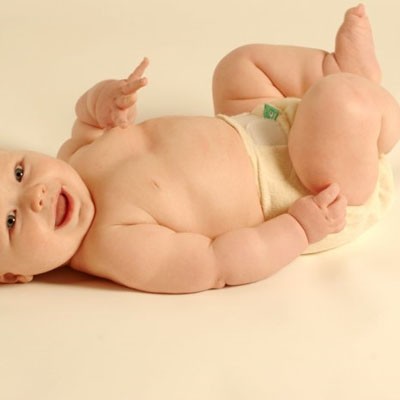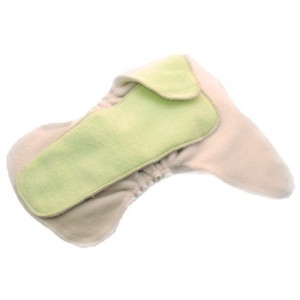
We’ve been comparing cloth diapers over the past few weeks, starting with one-piece diapers and moving toward simpler diapers. Today, we outline the benefits and drawbacks of fitted cloth diapers.
- All-in-One Diapers (AIO)
- Pocket Diapers
- Fitted Diapers
- Prefolds & Flat Diapers
Fitted Cloth Diapers
Every diapering system needs to include both moisture absorbency and moisture resistence. A fitted diaper has all of the absorbency and none of the moisture resistence. You need to use a waterproof cover over the top of fitteds. In an all-in-one diaper, these two pieces are combined.
A fitted diaper is a contour shape made of absorbent material. Gathering at the legs and waist as well as a closure at the waist make this fitted. Without the closure, and sometimes without the gathering, you have a contour diaper, which requires a Snappi or pins to hold it tight, though many parents choose to forgo closures altogether. Both fitted and contour diapers often have extra layers of absorbency down the center of the diaper where the baby wets.
Fitted diapers are a similar shape to pocket diapers, but the pocket diaper shape is created by non-absorbent material with the absorbency stuffed inside.
Fitted diapers can be one-size, though you might find that they create too much bulk on an infant and don’t give enough absorbency for a toddler. Even a two-sized diaper gives you more flexibility to get the absorbency right—and absorbency is key with any diaper.
If you prefer that your baby not feel wet, you can add a liner of silk or synthetic against the skin, but some parents prefer their baby to feel the wetness so they let the parent know that it is time for a diaper change or so a toddler feels the urge to use the toilet to avoid the wet diaper feeling.

Fitted Diaper Advantages
- No folding or stuffing.
- Easier to get clean than mixed fiber diaper systems.
- Cotton diapers can take a beating in the washer, dryer, and sun.
- Sized diapers don’t leave your tiny baby with a bulky bottom.
- Contour diapers have a lot of flexibility because you use a Snappi to customize fit.
- Gathered leg prevent leaks.
- You choose the kind of separate cover that works and fits best for your baby.
- You don’t need to wash the cover unless it has been soiled, so there is less wash than with pocket diapers or all-in-one cloth diapers.
Fitted Diaper Disadvantages
- You need to train caregivers to use a cover over the diaper.
- A contour diaper without gathering at legs and waist doesn’t always contain messes.
- When your baby grows out of a fitted diaper, you can’t use it as a doubler, burp cloth, or rag like you can with a prefold or flat diaper.
I have a difficult time coming up with disadvantages for fitted diapers because I have always found them my favorite type of diaper. If you have found disadvantages or advantages with fitted or any other type of diaper style we’ve been reviewing, please comment. A broader view will help new parents who are choosing diapers.
If you have used any of the fitted diapers sold at bynature.ca, please leave your reviews for others. Be specific. Tell people how the diapers worked and why. Later this week, we’ll share how our customers have reviewed fitted diapers.
